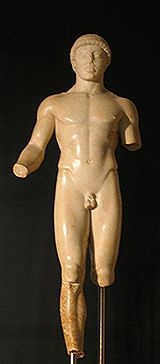
Ephebos
Encyclopedia

Greek language
Greek is an independent branch of the Indo-European family of languages. Native to the southern Balkans, it has the longest documented history of any Indo-European language, spanning 34 centuries of written records. Its writing system has been the Greek alphabet for the majority of its history;...
word for an adolescent age group or a social status reserved for that age in Antiquity
Classical antiquity
Classical antiquity is a broad term for a long period of cultural history centered on the Mediterranean Sea, comprising the interlocking civilizations of ancient Greece and ancient Rome, collectively known as the Greco-Roman world...
.
In Greece
Though the word can simply refer to the adolescent age of young men of training age, its main use is for the members, exclusively from that age group, of an official institution (ephebeia) that saw to building them into citizens, but especially training them as soldiers, sometimes already sent into the field; the GreekAncient Greece
Ancient Greece is a civilization belonging to a period of Greek history that lasted from the Archaic period of the 8th to 6th centuries BC to the end of antiquity. Immediately following this period was the beginning of the Early Middle Ages and the Byzantine era. Included in Ancient Greece is the...
city state (polis
Polis
Polis , plural poleis , literally means city in Greek. It could also mean citizenship and body of citizens. In modern historiography "polis" is normally used to indicate the ancient Greek city-states, like Classical Athens and its contemporaries, so polis is often translated as "city-state."The...
) mainly depended, as the Roman republic
Roman Republic
The Roman Republic was the period of the ancient Roman civilization where the government operated as a republic. It began with the overthrow of the Roman monarchy, traditionally dated around 508 BC, and its replacement by a government headed by two consuls, elected annually by the citizens and...
before Gaius Marius
Gaius Marius
Gaius Marius was a Roman general and statesman. He was elected consul an unprecedented seven times during his career. He was also noted for his dramatic reforms of Roman armies, authorizing recruitment of landless citizens, eliminating the manipular military formations, and reorganizing the...
' reform, on its militia of citizens for defence.
In Rome

Sculpture
In Ancient Greek sculptureAncient Greek sculpture
Ancient Greek sculpture is the sculpture of Ancient Greece. Modern scholarship identifies three major stages. They were used to depict the battles, mythology, and rulers of the land known as Ancient Greece.-Geometric:...
, an Ephebe is a sculptural type depicting a nude ephebos. (Archaic examples of the type are also often known as the kouros
Kouros
A kouros is the modern term given to those representations of male youths which first appear in the Archaic period in Greece. The term kouros, meaning youth, was first proposed for what were previously thought to be depictions of Apollo by V. I...
type, or kouroi in the plural.)
This typological name often occurs in the form "The X Ephebe", where X is the collection to which the object belongs or belonged, or the site on which it was found (eg the Agrigento Ephebe).
Sources and references
- Pauly-WissowaPauly-WissowaThe Realencyclopädie der Classischen Altertumswissenschaft, commonly called the Pauly–Wissowa or simply RE, is a German encyclopedia of classical scholarship. With its supplements it comprises over eighty volumes....
- H. Jeanmaire, Couroi et Courètes : essai sur l'éducation spartiate et sur les rites d'adolescence dans l'Antiquité hellénique, Bibliothèque universitaire, Lille, 1939 ;
- C. Pélékidis, Éphébie : histoire de l'éphébie attique, des origines à 31 av. J.-C., éd. de Boccard, Paris, 1962 ;
- O. W. Reinmuth, The Ephebic Inscriptions of the Fourth Century B.C., Leiden Brill, Leyde, 1971 ;
- P. Vidal-Naquet, « Le Chasseur noir et l'origine de l'éphébie athénienne », Le Chasseur noir. Formes de pensée et formes de société dans le monde grec, Maspéro, 1981 ;
- U. von Wilamowitz-Moellendorf, Aristoteles: Aristoteles und Athen, 2 vol., Berlin, 1916.

